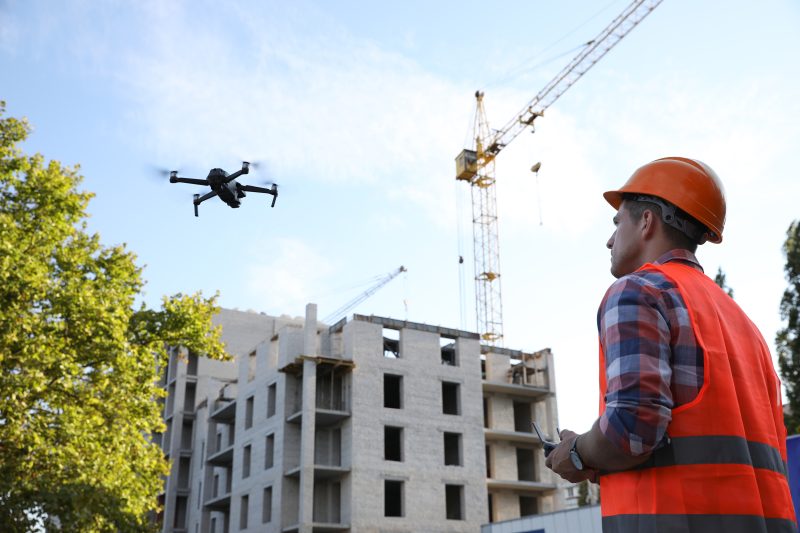3/6/25 – Safer and More Efficient: How Drones Are Revolutionizing Construction Site Safety

Safer and More Efficient: How Drones Are Revolutionizing Construction Site Safety
Safety on construction sites is a top priority, but it’s also one of the most challenging aspects of the industry. Every day, construction workers face hazards that can lead to serious accidents, injuries, or even fatalities. Despite ongoing safety protocols and advances in technology, construction sites remain one of the most dangerous workplaces in the world. However, drones are stepping in as a game-changing solution, offering a new way to enhance site safety, improve efficiency, and reduce risk for workers.
With the rise of drone technology, construction companies can now monitor job sites like never before. Drones equipped with high-resolution cameras and sensors can assess potential hazards, track progress in real-time, and provide critical safety data without putting anyone at risk. This revolutionary technology is making construction sites safer and more efficient than ever before.
1) The Current Challenges of Ensuring Safety on Construction Sites
Construction sites are inherently dangerous environments. With large machinery, heavy materials, and fast-paced work, accidents can happen in the blink of an eye. Common hazards include falls from heights, being struck by falling objects, electrical accidents, and machinery-related injuries. The statistics are alarming—according to the Occupational Safety and Health Administration (OSHA), the construction industry is responsible for one in five worker fatalities in the U.S.
Workplace hazards, such as unmarked dangerous areas, unstable structures, or inadequate safety gear, often lead to injuries. Despite efforts to improve construction site safety, accidents still occur at an alarming rate. That’s where drones come in—by providing an innovative solution to enhance safety measures and reduce risks on the job site.
2) How Drones Are Being Used for Safety on Construction Sites
Drones are being deployed on construction sites for a variety of safety purposes. One of the most important uses is monitoring the site for potential hazards. Drones equipped with high-definition cameras and sensors can perform real-time inspections of areas that would otherwise be hard to reach, such as roofs, scaffolding, or unstable structures.
These drones can capture high-resolution images and video footage that allow site managers to assess conditions from a distance. By flying drones over construction zones, safety managers can identify potential hazards such as unsecured materials, structural issues, or workers without proper safety equipment—all without putting anyone in harm’s way.
Additionally, drones can assist with mapping and surveying construction sites, allowing for more accurate planning and reducing human error. This use of drones not only improves construction site safety but also enhances the overall workflow by enabling quick and accurate assessments.
3) The Benefits of Using Drones for Safety on Construction Sites
There are numerous benefits to integrating drones into construction site safety practices. First and foremost, drones improve efficiency by reducing the need for manual inspections. Traditionally, safety managers would need to walk the entire site, often climbing ladders or scaffolding, to check for hazards. Drones eliminate this need, allowing for quicker, safer inspections that can be done remotely.
By identifying safety hazards early on, drones help to prevent accidents before they occur. For example, drones can spot unsafe work practices, such as workers not wearing proper fall protection or improper storage of materials. By addressing these issues in real-time, companies can prevent costly accidents and injuries.
The use of drones also leads to significant cost savings. With fewer accidents, construction companies experience fewer worker compensation claims and lower insurance premiums. Additionally, drones help to optimize resources, saving time and money on manual inspections, improving project timelines, and reducing operational costs.
4) Real-Life Examples of Drones Improving Construction Site Safety
Several companies have already seen the benefits of using drones for safety on their construction sites. One notable example is the use of drones by Skanska USA, which has successfully integrated drones into their safety protocols to conduct aerial inspections. By using drones to assess site conditions and monitor workers’ compliance with safety standards, they’ve been able to identify potential hazards and address them quickly.
Another example comes from Turner Construction, which utilized drones to monitor a large-scale project in New York City. Drones allowed the safety team to survey hard-to-reach areas, such as the tops of high-rise buildings, where workers may be exposed to significant fall hazards. By implementing drones for safety inspections, Turner was able to reduce safety risks and improve overall project efficiency.
These real-life examples show how drones can be used effectively to improve safety, prevent accidents, and enhance overall construction site management.
Drones are reshaping the construction industry, offering new ways to improve safety and efficiency on construction sites. By providing real-time monitoring, capturing high-resolution footage, and identifying hazards early, drones are helping to make construction work safer and more cost-effective. As the technology continues to evolve, the potential for drones to revolutionize construction site safety is immense.
For construction companies looking to stay ahead of the curve, integrating drones into safety protocols is not just an option—it’s a necessity. By adopting this innovative technology, companies can ensure that their workers are safer, their projects are completed on time, and their bottom line benefits from the efficiencies drones provide.
Have you implemented drones on your construction site? Share your experiences in the comments on our Instagram page, and let’s start a conversation about the future of safety in construction. Don’t forget to share this post with your network to help spread the word about how drones are revolutionizing the construction industry!
Turn to the Gould Construction Institute for high quality cost-effective training.
